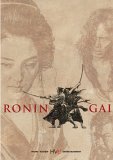| Reviews & Columns |
|
Reviews DVD TV on DVD Blu-ray 4K UHD International DVDs In Theaters Reviews by Studio Video Games Features Collector Series DVDs Easter Egg Database Interviews DVD Talk Radio Feature Articles Columns Anime Talk DVD Savant Horror DVDs The M.O.D. Squad Art House HD Talk Silent DVD
|
DVD Talk Forum |
|
|
| Resources |
|
DVD Price Search Customer Service #'s RCE Info Links |
|
Columns
|
|
|
Ronin Gai
Shochiku's Ronin Gai is a handsome attempt to recreate the emotional charge of classic swordplay dramas, most notably Kurosawa's Seven Samurai. A quartet of de-classed warriors wallows in self-pity until a finale that inspires them to once again do honorable battle. The film has interesting characterizations and attractive color cinematography, yet despite its origins seems like a belated attempt to graft American-style action formulas onto a Japanese staple.
The film marks the final appearance of Shintaro Katsu, the hero of dozens of Zatoichi blind swordsman films.
Ronin Gai begins with a dedication to Shozo Makino, a silent filmmaker who introduced western techniques to Japanese film. The story was filmed at least four times, one of them by Makino's son in the late 1920s. On this 1990 production the most powerful influence is one of its stars, Shintaro Katsu of Zatoichi blind swordsman fame. The liner notes essay by Mark Pollard explains that not only was filming delayed so that Katsu could participate, he also held up the set whenever he wanted to hear the racing results over the radio.
The story is a lively if predictable conflict of once-noble men reduced to humiliating poverty. They brawl, cheat and suffer in shame. Gennai has lowered himself to living from the earnings of Oshin, and heaps abuse upon her while refusing to give her up. Horo also lusts after Oshin but hasn't the nerve to claim her for his own. The lowly bird breeder gives his sister Obun a hard time for trying to help him - even if he were to receive a commission from a lord, he could never afford the expensive bribes needed to purchase the office.
The story builds with a series of bloody sword murders of prostitutes, and it doesn't take long to discover that the culprits are a group of depraved samurai seeking sport by killing "unclean" women. Just as in a western, our fallen heroes look the other way until the stakes get too high, at which point both they and we are good and ready for a showdown.
To save the women of his reading class, Bull sells himself into abject servility to one of the evil samurai, who enjoys watching him fetch sticks and bark like a dog. It is Bull who suggests the barbaric death for their latest prisoner, Oshin: to be drawn to pieces between two oxen. But Bull is buying time, hoping that Oshin's lovers Gennai and Horo will come to the rescue.
The final battle is a satisfactory melee marked by Gennai's wild contortions and the sight of Horo's white robe being splashed with enemy blood. The staging is vigorous enough but the fight is the generic kind that features scores of bad guys who encircle a hero only to unaccountably attack him one at a time, as if waiting for their turn to die. None can be bothered to stab their outnumbered prey when his back is turned. For this reviewer the best 'one against many' samurai battles are those that take place in confined spaces.
All four heroes find noble destinies, with Bull recouping his honor in a deliciously outrageous way. (spoiler) Sworn by oath to shield his unworthy master, he stabs him to death on the tip of a sword that he first runs through himself! The maintenance of personal honor can be very painful.
Modern viewers surely responded to Ronin Gai as a solid action drama and not as a traditional story like Chushingura. The unwashed ex-samurai heroes are fun to watch, particularly Katsu and Yoshio Harada. One of them straps on his armor again and charges into battle atop a workhorse. That must have been an audience-pleasing moment.
Home Vision Entertainment's DVD of Ronin Gai is a fine-looking disc with excellent color; even night scenes have depth and detail. The lively soundtrack helps us feel the din of the frequent downpours and allows us to appreciate a blind biwa musician as he provides an accompaniment for the final battle. There are no video extras but Mark Pollard's liner notes lay out the essential historical background.
On a scale of Excellent, Good, Fair, and Poor, Ronin Gai rates:
Movie: Very Good
Video: Excellent
Sound: Excellent
Supplements: trailer
Packaging: Keep case
Reviewed: May 21, 2005
| |
|
| Popular Reviews |
| Sponsored Links |
|
|
| Sponsored Links |
|
|
| Release List | Reviews | Shop | Newsletter | Forum | DVD Giveaways | Blu-Ray | Advertise |
|
Copyright 2024 DVDTalk.com All Rights Reserved. Legal Info, Privacy Policy, Terms of Use,
Manage Preferences,
Your Privacy Choices | |||||||













